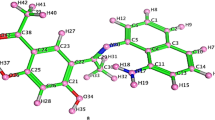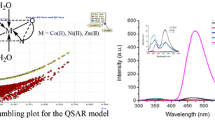Abstract
A novel tridentate Schiff’s base ligand 2-acetyl-5-methyl-furanthiosemicarbazone was isolated from 2-acetyl-5-methyl-furan (0.001 mol) and thiosemicarbazide (0.001 mol) in ethanolic medium in 1:1 ratio at pH 3–4. Isolated ligand was structurally characterized by melting point, elemental analysis, 1H-NMR, Mass, UV and IR studies. Mn(II), Co(II), Ni(II), and Cu(II), and metal complexes of Schiff’s base ligand were also synthesized and characterized by analytical method, melting point analysis, element analysis, molar conductance, magnetic moment and spectral studies IR, electronic spectra, and EPR spectra. On the basis of spectral studies, transition metal complexes have the general composition [ML2]Cl2 where M = Mn(II), Co(II), Ni(II), and Cu(II), L = 2-acetyl-5-methyl-furanthiosemicarbazone. Molar conductance values suggested electrolytic nature of metal complexes by the composition [ML2]Cl2. On the basis of spectral studies, six coordinated octahedral/tetragonal geometries were assigned for the synthesized complexes. Molecular modeling of ligand and complexes was also done by using Gaussian. All synthesized compounds were also examined to evaluate their antibacterial potential against bacteria E. coli and S. typhi. On the basis of antimicrobial results, it was concluded that metal complexes exhibited higher inhibition potential than free Schiff’s base ligand.









Similar content being viewed by others
References
Al-Hamdani AAS, Zoubi WA (2015) New metal complexes of N3 tridentate ligand: synthesis, spectral studies and biological activity. Spectrochim Acta Part A Mol Biomol Spectrosc 137:75–89
Aly MM, Mohamed YA, El-Bayouki KAM, Basyouni WM, Abbas SY (2010) Synthesis of some new 4(3H)-quinazolinone-2-carboxaldehyde thiosemicarbazones and their metal complexes and a study on their anticonvulsant, analgesic, cytotoxic and antimicrobial activities—part-1. Eur J Med Chem 45(8):3365–3373
Bhaumik PK, Harms K, Chattopadhyay S (2013) Synthesis and characterization of four dicyanamide bridged copper(II) complexes with N2O donor tridentate Schiff bases as blocking ligands. Inorg Chim Acta 405:400–409
Burlov AS, Uraev AI, Garnovskii DA, Lyssenko KA, Vlasenko VG, Zubavichus YV, Murzin VY, Korshunova EV, Borodkin GS, Levchenkov SI, Vasilchenko IS, Minkin VI (2014) Synthesis, XAFS and X-ray structural studies of mono- and binuclear metal-chelates of N, O, O(N, O, S) tridentate Schiff base pyrazole derived ligands. J Mol Struct 1064:111–121
Chandra S, Gautam S (2014) Antibacterial and antifungal activity of Schiff base ligands and their metal complexes-A Review. Int J Chem Pharm Sci 5:27–41
Chandra S, Ruchi (2013) Synthesis, spectroscopic characterization, molecular modeling and antimicrobial activities of Mn(II), Co(II), Ni(II), Cu(II) complexes containing the tetradentate aza Schiff base ligand. Spectrochim Acta Part A Mol Biomol Spectrosc 103:338–348
Dhanaraj CJ, Johnson J (2014) Synthesis, characterization, electrochemical and biological studies on some metal(II) Schiff base complexes containing quinoxaline moiety. Spectrochim Acta Part A Mol Biomol Spectrosc 118:624–631
Ebrahimi HP, Hadi JS, Alsalim TA, Ghali TS, Bolandnazar Z (2015) A novel series of thiosemicarbazone drugs: from synthesis to structure. Spectrochim Acta Part A Mol Biomol Spectrosc 137:1067–1077
El-halim HFA, Omar MM, Mohamed GG (2011a) Synthesis, structural, thermal studies and biological activity of a tridentate Schiff base ligand and their transition metal complexes. Spectrochim Acta Part A Mol Biomol Spectrosc 78:36–44
El-halim HFA, Omar MM, Mohamed GG, Sayed MAE (2011b) Spectroscopic and biological activity studies on tridentate Schiff base ligands and their transition metal complexes. Eur J Chem 2:178–188
Goel P, Kumar D, Chandra S (2014) Schiff’s Base Ligands and their transition metal complexes as Antimicrobial agents. J Chem Biol Phy Sci 4:1946–1964
Gokhale N, Jain S, Yadav M (2015) Design and virtual screening towards synthesis of novel substituted thiosemicarbozones as ribonuleotide reductase (RNR) inhibitors with improved cellular trafficking and anticancer activity. Curr Top Med Chem 15:37–42
Hill HAO, Sadler PJ (2016) Bringing inorganic chemistry to life with inspiration from R. J. P Williams. J Biol Inorg Chem 21:5–12
Holm RH, Kennepohl P, Solomon EI (1996) Structural and functional aspects of metal sites in biology. Chem Rev 96:2239–2314
Huang H, Chen Q, Ku X, Meng L, Lin L, Wang X, Zhu C, Wang Y, Chen Z, Li M, Jiang H, Chen K, Ding J, Liu H (2010) A series of heterocyclic carboxaldehyde thiosemicarbazones inhibit to poisomerase II catalytic activity. J Med Chem 53:3048–3064
Jadhav SM, Shelke VA, Shankarwar SG, Munde AS, Chondhekar TK (2014) Synthesis, spectral, thermal, potentiometric and antimicrobial studies of transition metal complexes of tridentate ligand. J Saudi Chem Soc 18:27–34
Kathiresan S, Anand T, Mugesh S, Annaraj J (2015) Synthesis, Spectral Characterization and DNA bindings of Tridentate N2O donor Schiff base Metal (II) Complexes. J Photochem Photobiol B 148:290–301
Kpomah B, Egboh SHO, Agbaire PO, Kpomah ED (2016) Metal Complexes of acetone thiosemicarbazone: synthesis, spectral characterization and pharmacological studies. J Pharm Appl Chem 2:45–50
Kulandaivelu U, Padmini VG, Suneetha K, Shireesha B, Vidyasagar JV, Rao TR, Basu JKNA, Jayaprakash V (2011) Synthesis, antimicrobial and anticancer activity of new thiosemicarbazone derivatives. Arch Pharm 344:84–90
Mohamed NA, Mohamed RR, Seoudi RS (2014) Synthesis and characterization of some novel antimicrobial thiosemicarbazone O-carboxymethyl chitosan derivatives. Int J Biol Macromol 63:163–169
Molina-López J, Pozo EP, Florea DI, Fernandez C, Osso BQ, Zalewska M, Krizkova S, Heger Z, Kizek R, Adam V (2016) Nutritional and methodological perspectives of zinc ions and complexes-physiological and pathological states. Int J Electrochem Sci 11:4470–4496
Moorthy NS, Cerqueira NM, Ramos MJ, Fernandes PA (2013) Aryl- and heteroaryl-thiosemicarbazone derivatives and their metal complexes: a pharmacological template. Recent Pat Anti-Cancer Drug Discovery 8:168–182
Nagesh GY, Mruthyunjayaswamy BHM (2015) Synthesis, characterization and biological relevance of some metal (II) complexes with oxygen, nitrogen and oxygen (ONO) donor Schiff base ligand derived from thiazole and 2-hydroxy-1-naphthaldehyde. J Mol Struct 1085:198–206
Pahont E, Paraschivescu C, Ilies DC, Poirier D, Oprean C, Paunescu V, Gulea A, Ros T, Bratu O (2016) Synthesis and characterization of novel Cu(II), Pd(II) and Pt(II) complexes with 8-ethyl-2-hydroxytricyclo(7.3.1.02,7)tridecan-13-onethiosemicarbazone: antimicrobial and in vitro Antiproliferative Activity. Molecules 21:674
Reddy NS, Shankara BS, Murali Krishana P, Basavaraj C, Mahesh B (2013) Synthesis, characterization, and antibacterial activity of Co(II), Ni(II), Cu(II), Zn(II), Cd(II), and Hg(II) complexes of Schiff’s Base type ligands containing benzofuran moiety. Int J Inorg Chem 2013:1–10
Sharma AK, Chandra S (2011) Complexation of nitrogen and sulphur donor Schiff’s base ligand to Cr(III) and Ni(II) metal ions: synthesis, spectroscopic and antipathogenic studies. Spectrochim Acta Part A Mol Biomol Spectrosc 78:337–342
Sharma AK, Chandra S (2013) Synthesis, structural and fungicidal studies of hydrazone based coordination compounds. Spectrochim Acta Part A Mol Biomol Spectrosc 103:96–100
Stefankiewicz AR, Wałęsa-Chorab M, Szcześniak HB, Patroniak V, Kubicki M, Hnatejko Z, Harrowfield J (2010) Grid-corner analogues: synthesis, characterisation and spectroscopic properties of meridional complexes of tridentate NNO Schiff-base ligands. Polyhedron 29:178–187
Tyagi M, Chandra S (2014) Synthesis and spectroscopic studies of biologically active tetraazamacrocyclic complexes of Mn(II), Co(II), Ni(II), Pd(II) and Pt(II). J Saudi Chem Soc 18:53–58
Tyagi M, Chandra S, Tyagi P (2014) Mn(II) and Cu(II) complexes of a bidentate Schiff’s base ligand: spectral, thermal, molecular modeling and mycological studies. Spectrochim Acta Part A Mol Biomol Spectrosc 117:1–8
Venkatesh K, Rayam P, Sekhar KBC, Mukkantia K (2016) Thiosemicarbazide derivatives and their transition metal complexes. Int J Appl Biol Pharm Tech 7:258–266
Verma KK, Soni Gupta P, Solanki K, Bhojak N (2015) Microwave assisted synthesis, characterisation and antimicrobial activities of few Cobalt(II) thiosemicarbazones complexes. World J Pharm Pharm Sci 4:1673–1683
Acknowledgements
Ms. Pallavi Goel (Jain) is thankful to Dr. (Prof) Manoj Kumar Pandey, Director, SRM University, Modinagar, for providing facilities and for his encouragements to do Ph.D. research work and publication of papers. The author is grateful to her guide and co-guide for their research guidance and proper support. The author is also thankful to IIT Bombay for recording EPR spectra, IIT Delhi, for recording NMR, Mass, and IR spectra.
Author information
Authors and Affiliations
Corresponding author
Rights and permissions
About this article
Cite this article
Goel, P., Kumar, D., Chandra, S. et al. Synthesis and Spectroscopic Study of Biologically Active Tridentate Schiff’s Base Ligand 2-Acetyl-5-methyl-furanthiosemicarbazone and its Mn(II), Co(II), Ni(II), and Cu(II) Complexes. Iran J Sci Technol Trans Sci 42, 557–565 (2018). https://doi.org/10.1007/s40995-016-0140-6
Received:
Accepted:
Published:
Issue Date:
DOI: https://doi.org/10.1007/s40995-016-0140-6




